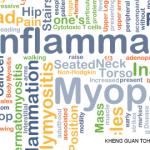Certain illness characteristics and conditions have been identified as triggers to consult specialty palliative care for individuals with severe neurologic disease.22 In motor-neuron disease, difficulties with respiration or eating, a rapid decline in mobility, weight loss and psychosocial distress have been identified as possible triggers for palliative care referrals.23 Using similar triggers to automate palliative care referral for patients with IBM may facilitate access to services that patients may not encounter otherwise.
Given that aspiration and respiratory failure are common causes of morbidity in patients with IBM, recurrent aspirations could serve as a sign of disease progression. Similarly, a change in physical status, such as worsening weakness or new dependence on an assistive device, may be another trigger. This should signal a need for more focused interventions and consideration for referral to specialist palliative care.
Alternatively, as in a model utilized in our institution for amyotrophic lateral sclerosis, palliative care evaluations can be incorporated from the initial contact at the specialty center to normalize conversations and identify needs at each stage of the disease.24
In a very real sense, one could consider all available treatments for patients with IBM as palliative in nature. Yet complex symptom management, discussions around complex decisions and advance care planning, and partner support remain areas of care that need further addressing.
In Sum
The future of clinical care and research in IBM should evaluate and expand on palliative skills for IBM healthcare providers and the integration of specialty palliative care for these vulnerable patients. Given their expertise in IBM, multi-system disease and focus on whole-person care, rheumatologists are uniquely suited to lead this effort. Further, implementation of palliative care modalities for this patient population can serve as a stepping stone to integrating these practices for other complex, incurable rheumatic diseases.
 Kamini E. Kuchinad, MD, MPH, completed her rheumatology fellowship at the Johns Hopkins University School of Medicine, Baltimore, and will be an assistant professor of medicine in the Division of Arthritis and Rheumatic Diseases, Oregon Health & Science University, and the VA Portland Health Care System, Portland, Ore.
Kamini E. Kuchinad, MD, MPH, completed her rheumatology fellowship at the Johns Hopkins University School of Medicine, Baltimore, and will be an assistant professor of medicine in the Division of Arthritis and Rheumatic Diseases, Oregon Health & Science University, and the VA Portland Health Care System, Portland, Ore.
 Ambereen Mehta, MD, MPH, is an associate professor of palliative care in the departments of medicine and neurology at the Johns Hopkins University School of Medicine, Baltimore, and works in the palliative care program at Johns Hopkins Bayview Medical Center, Baltimore.
Ambereen Mehta, MD, MPH, is an associate professor of palliative care in the departments of medicine and neurology at the Johns Hopkins University School of Medicine, Baltimore, and works in the palliative care program at Johns Hopkins Bayview Medical Center, Baltimore.
 David Wu, MD, is the director of the palliative care program at Johns Hopkins Bayview Medical Center, Baltimore, and an associate professor of medicine at the Johns Hopkins University School of Medicine, Baltimore.
David Wu, MD, is the director of the palliative care program at Johns Hopkins Bayview Medical Center, Baltimore, and an associate professor of medicine at the Johns Hopkins University School of Medicine, Baltimore.


